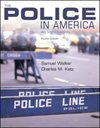Lecture Outline
I. Why police?
A. Traditional explanations of the police role are too simplistic
B. Role of the police is extremely complex
II. Myths about policing
A. Police are primarily crime-fighters
1. Police spend most of their time enforcing the criminal law, patrolling to deter crime, investigating crimes, and arresting criminals
2. Inaccurate image: patrol officers spend only 1/3 of their time on law enforcement
3. Most officer time is spent on peacekeeping, order maintenance or problem solving
B. Sources of crime-fighter image
1. Entertainment media: movies and television popularize this image
2. News media: dramatize serious crimes, victims, and violence
3. Police: press releases and annual reports emphasize crime and arrests
C. Consequences of the crime-fighter image
1. Ignores order maintenance and peacekeeping activities that consume most police time and effort
2. Makes evaluating police performance difficult
3. Creates unrealistic public expectations about ability of the police to prevent crime and catch criminals
4. Management is difficult for police chiefs
5. Creates role conflict for individual officers
III. Realities of policing; the role of the police is extremely complex
A. Involves wide variety of tasks-few items involve criminal law enforcement
B. Many of the tasks extremely vague
C. Different tasks often conflict with each other
D. Officers exercise a great amount of discretion in police work
IV. Factors that shape the police role
A. Police roles and responsibilities (ABA)
1. Identify criminal offenders and criminal activity--apprehend offenders and participate in prosecution
2. Reduce opportunity for crime
3. Aid individuals in harm of danger
4. Protect constitutional guarantees
5. Traffic
6. Assist those who cannot care for themselves
7. Resolve conflict
8. Identify potentially serious law enforcement or government problems
9. Create and maintain community security
10. Promote and preserve civil order
11. Provide other emergency services
B. Police services available 24 hours a day
1. No other social or government agency provides this service
2. Public wants an emergency service to respond to handle all problems that arise
3. Results in heavy officer workload
4. Police serve as "generalists"--expected to handle wide range of situations with limited training
C. Authority to use force, includes power to use deadly and physical force, powers of arrest
1. Power of force and arrest limited by the law
2. Can only be used in performance of job
3. Cannot be used frivolously or maliciously
4. Defining feature of relations between officers and citizens
D. The police and social control
1. Police contribute to social control through:
a. law enforcement
b. order maintenance activities
2. Police task is to preserve societal norms by:
a. deterring crime
b. arresting criminal offenders
3. Police presence is intended to preserve order by:
a. serving as a deterrent to misconduct
b. providing quick response for potential or low-level problems
4. Capacity of police to exercise social control is limited
a. routine patrol has only a limited effect on crime
b. ability of police to identify and arrest criminal suspects is limited
5. Police rely on citizens to:
a. report crimes
b. provide information about suspects
c. cooperate in investigations
E. The police and social control systems
1. "Gatekeepers" of the criminal justice system--determine the workload for the system
2. Social welfare system
a. police are often first contact that official agencies have with delinquency, family problems, etc.
b. police often make referrals to social service agencies
3. Political system
a. ensures public control and accountability of the police
b. police are symbols of the political system, most visible representation of power in society
c. attitudes toward police are influenced by attitudes toward political system
V. Possibilities
A. Functional specialization
1. Community service officers (CSOs) handle non-emergency calls for service
2. Police officers perform tasks currently handled by police
3. Police agents concentrate on investigation with specialty areas(EX: rape)
4. Does not resolve problems surrounding complexity of the police role
B. Problem-oriented policing
1. Police identify specific crimes--develop appropriate responses
2. Research and planning
3. Problem-oriented approach vs. traditional police role
a. proactive vs. reactive approach
b. concern with underlying problems vs. calls for service
4. Newport News Experiment
C. Community policing
1. Alters basic philosophy of policing
2. Community policing approach vs. traditional police role
a. work closely with citizens vs. inward-looking bureaucracy
b. crime prevention vs. law enforcement
c. decentralization vs. military style organization
3. Can take many different forms(EX: CPOP, CAPS, SMART programs)
D. Zero tolerance policing
1. Focuses on minor quality of life issues
(EX: urinating in public, farebeating)
2. Proponents: can lead to reduction in serious crimes
3. Opponents: encourages police abuse of citizens
E. Honest law enforcement
1. Police continue to do what they now do well, but are honest to themselves and public about it
2. Continue patrol, answer calls for service, try to apprehend offenders
3. Do not claim that they are preventing crime
VI. The implications of change: basic issues that must be faced regardless of approach
A. Mission
B. Patrol operations
C. Calls for service
D. Discretion
E. Police-community relations
F. Corruption
G. Accountability
H. Personnel
I. Organization
|



 2002 McGraw-Hill Higher Education
2002 McGraw-Hill Higher Education